CSR Implementation: Firm Strategies for Social Responsibility
VerifiedAdded on 2023/06/11
|21
|4575
|216
Report
AI Summary
This report investigates how firms effectively implement Corporate Social Responsibility (CSR) in society, examining their strategies and impact on stakeholders. It delves into organizational policies, stakeholder relationships, and environmental sustainability efforts. The research aims to understand the link between CSR activities and organizational goals, as well as the benefits to the community and society at large. The study also explores the ethical considerations and value-driven practices that drive CSR adoption, emphasizing the importance of balancing economic development with social and environmental responsibility. Ultimately, the report seeks to provide insights into how firms can successfully integrate CSR into their operations and contribute to the well-being of society.
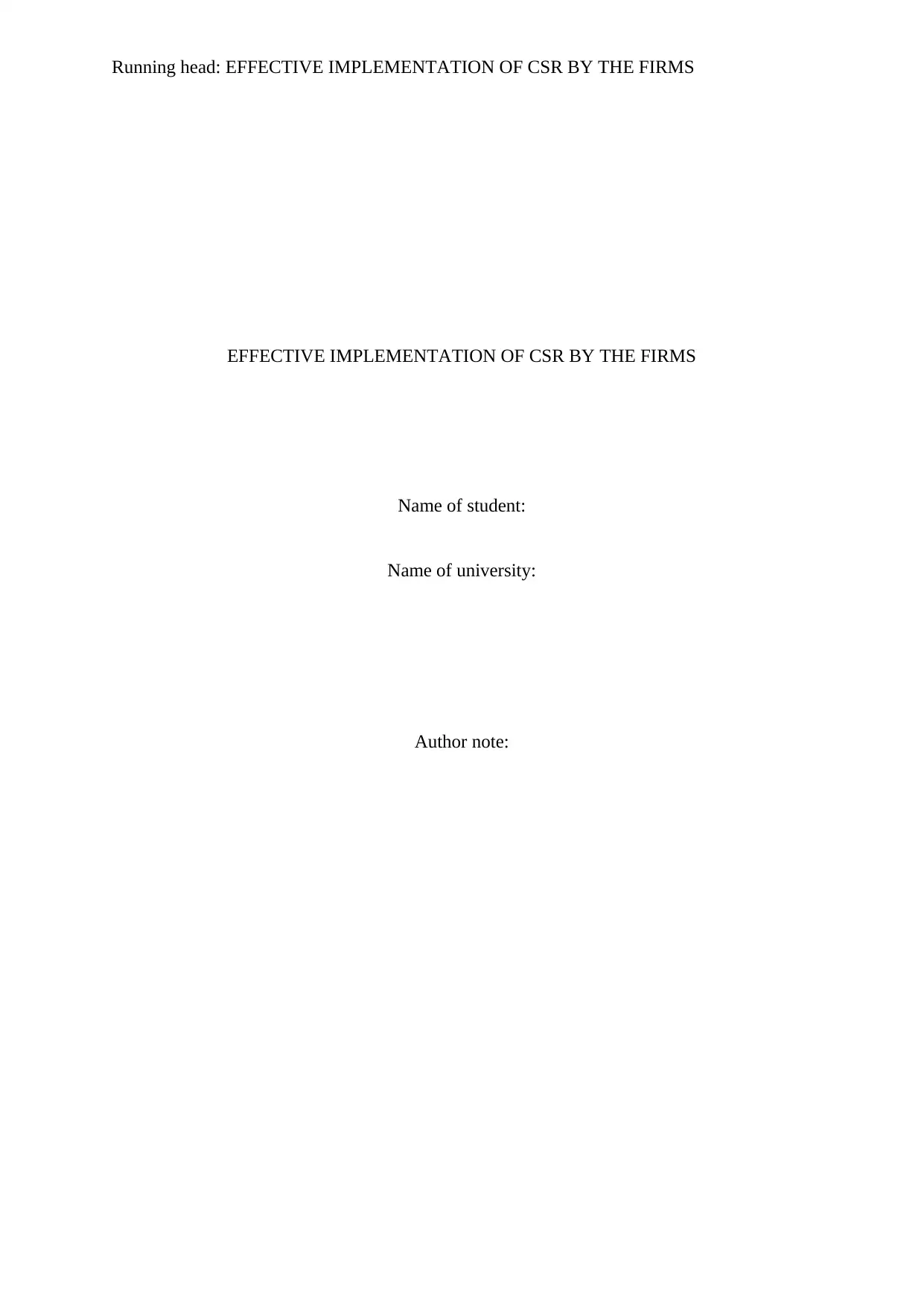
Running head: EFFECTIVE IMPLEMENTATION OF CSR BY THE FIRMS
EFFECTIVE IMPLEMENTATION OF CSR BY THE FIRMS
Name of student:
Name of university:
Author note:
EFFECTIVE IMPLEMENTATION OF CSR BY THE FIRMS
Name of student:
Name of university:
Author note:
Paraphrase This Document
Need a fresh take? Get an instant paraphrase of this document with our AI Paraphraser
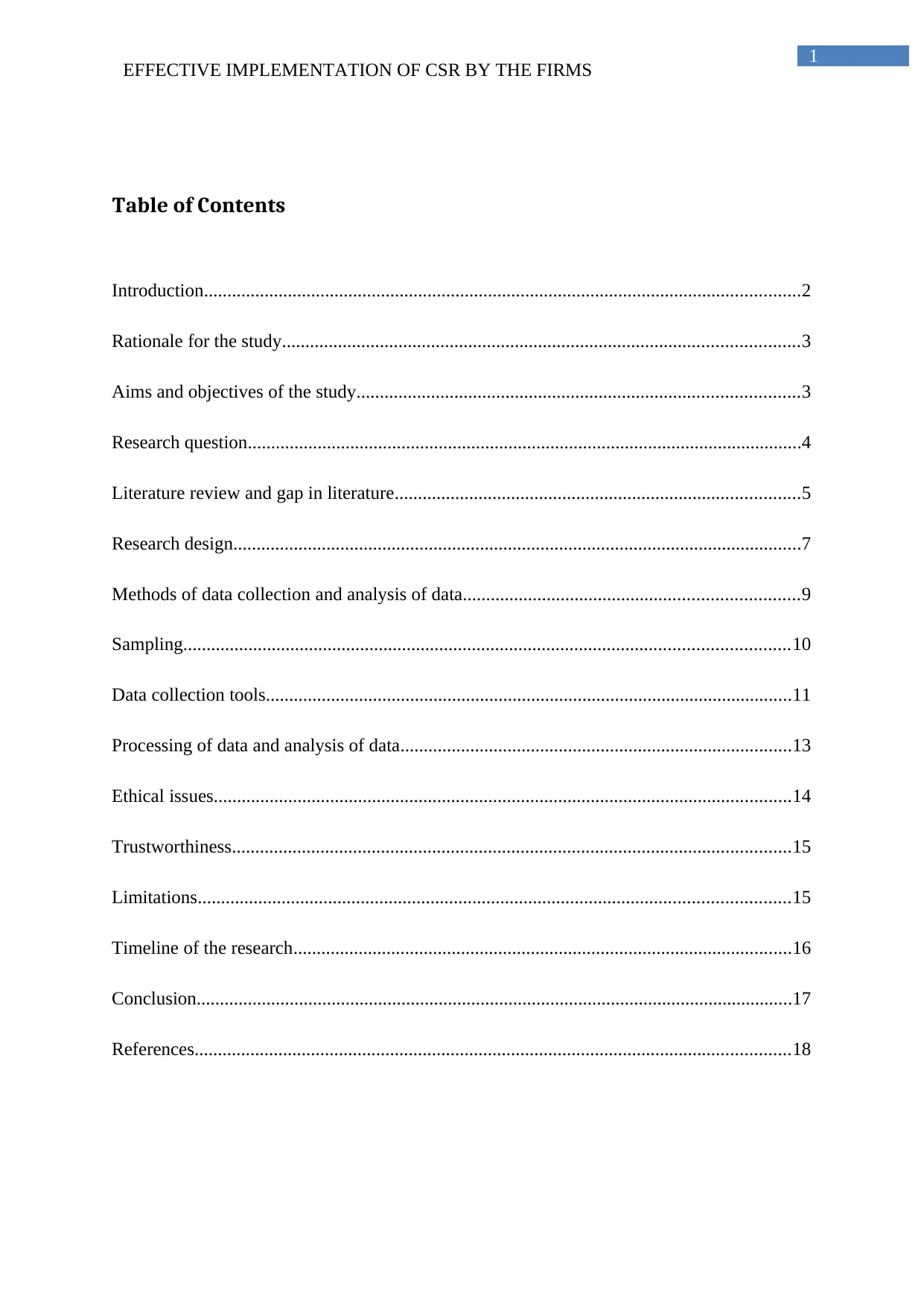
1
EFFECTIVE IMPLEMENTATION OF CSR BY THE FIRMS
Table of Contents
Introduction................................................................................................................................2
Rationale for the study...............................................................................................................3
Aims and objectives of the study...............................................................................................3
Research question.......................................................................................................................4
Literature review and gap in literature.......................................................................................5
Research design..........................................................................................................................7
Methods of data collection and analysis of data........................................................................9
Sampling..................................................................................................................................10
Data collection tools.................................................................................................................11
Processing of data and analysis of data....................................................................................13
Ethical issues............................................................................................................................14
Trustworthiness........................................................................................................................15
Limitations...............................................................................................................................15
Timeline of the research...........................................................................................................16
Conclusion................................................................................................................................17
References................................................................................................................................18
EFFECTIVE IMPLEMENTATION OF CSR BY THE FIRMS
Table of Contents
Introduction................................................................................................................................2
Rationale for the study...............................................................................................................3
Aims and objectives of the study...............................................................................................3
Research question.......................................................................................................................4
Literature review and gap in literature.......................................................................................5
Research design..........................................................................................................................7
Methods of data collection and analysis of data........................................................................9
Sampling..................................................................................................................................10
Data collection tools.................................................................................................................11
Processing of data and analysis of data....................................................................................13
Ethical issues............................................................................................................................14
Trustworthiness........................................................................................................................15
Limitations...............................................................................................................................15
Timeline of the research...........................................................................................................16
Conclusion................................................................................................................................17
References................................................................................................................................18
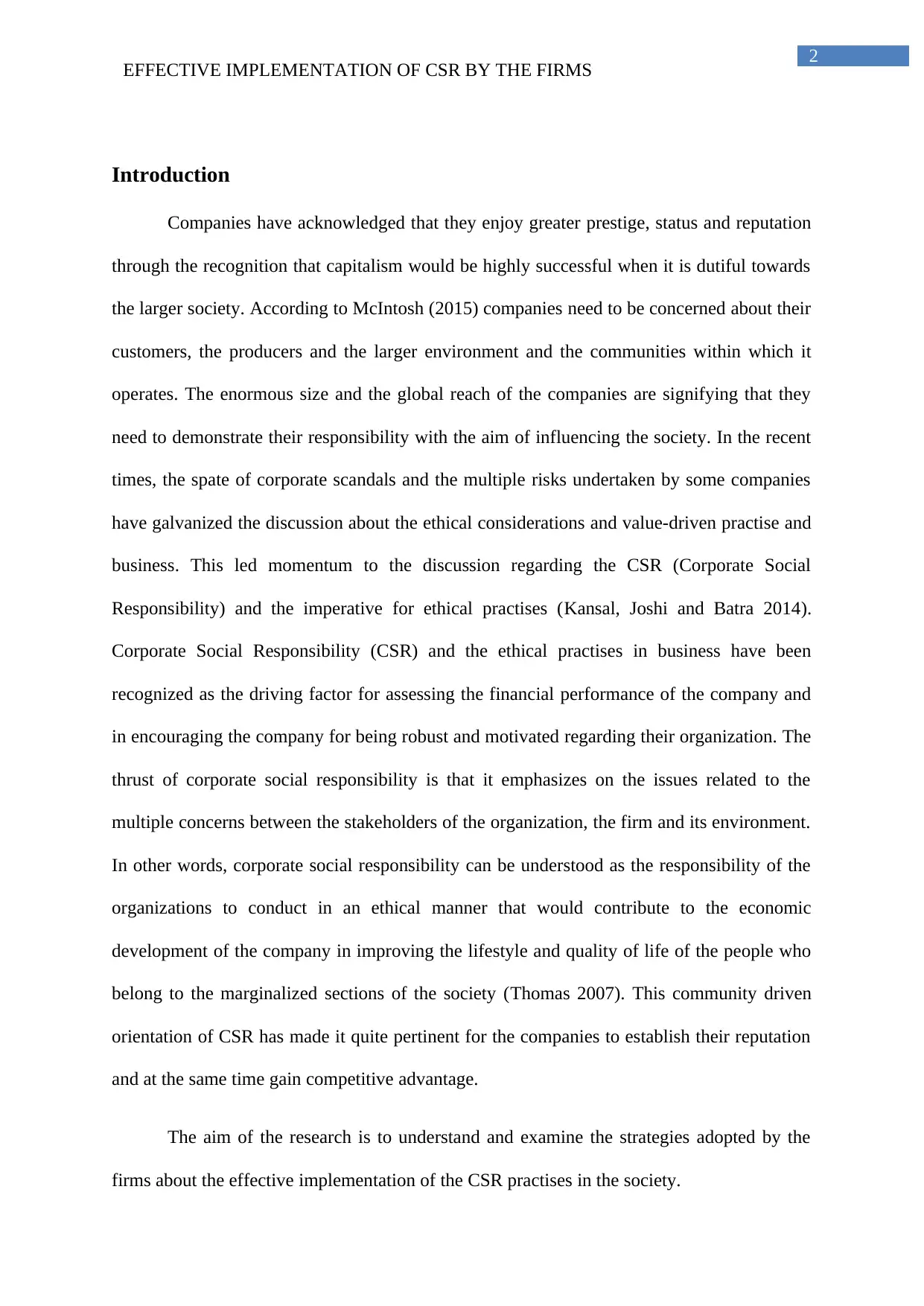
2
EFFECTIVE IMPLEMENTATION OF CSR BY THE FIRMS
Introduction
Companies have acknowledged that they enjoy greater prestige, status and reputation
through the recognition that capitalism would be highly successful when it is dutiful towards
the larger society. According to McIntosh (2015) companies need to be concerned about their
customers, the producers and the larger environment and the communities within which it
operates. The enormous size and the global reach of the companies are signifying that they
need to demonstrate their responsibility with the aim of influencing the society. In the recent
times, the spate of corporate scandals and the multiple risks undertaken by some companies
have galvanized the discussion about the ethical considerations and value-driven practise and
business. This led momentum to the discussion regarding the CSR (Corporate Social
Responsibility) and the imperative for ethical practises (Kansal, Joshi and Batra 2014).
Corporate Social Responsibility (CSR) and the ethical practises in business have been
recognized as the driving factor for assessing the financial performance of the company and
in encouraging the company for being robust and motivated regarding their organization. The
thrust of corporate social responsibility is that it emphasizes on the issues related to the
multiple concerns between the stakeholders of the organization, the firm and its environment.
In other words, corporate social responsibility can be understood as the responsibility of the
organizations to conduct in an ethical manner that would contribute to the economic
development of the company in improving the lifestyle and quality of life of the people who
belong to the marginalized sections of the society (Thomas 2007). This community driven
orientation of CSR has made it quite pertinent for the companies to establish their reputation
and at the same time gain competitive advantage.
The aim of the research is to understand and examine the strategies adopted by the
firms about the effective implementation of the CSR practises in the society.
EFFECTIVE IMPLEMENTATION OF CSR BY THE FIRMS
Introduction
Companies have acknowledged that they enjoy greater prestige, status and reputation
through the recognition that capitalism would be highly successful when it is dutiful towards
the larger society. According to McIntosh (2015) companies need to be concerned about their
customers, the producers and the larger environment and the communities within which it
operates. The enormous size and the global reach of the companies are signifying that they
need to demonstrate their responsibility with the aim of influencing the society. In the recent
times, the spate of corporate scandals and the multiple risks undertaken by some companies
have galvanized the discussion about the ethical considerations and value-driven practise and
business. This led momentum to the discussion regarding the CSR (Corporate Social
Responsibility) and the imperative for ethical practises (Kansal, Joshi and Batra 2014).
Corporate Social Responsibility (CSR) and the ethical practises in business have been
recognized as the driving factor for assessing the financial performance of the company and
in encouraging the company for being robust and motivated regarding their organization. The
thrust of corporate social responsibility is that it emphasizes on the issues related to the
multiple concerns between the stakeholders of the organization, the firm and its environment.
In other words, corporate social responsibility can be understood as the responsibility of the
organizations to conduct in an ethical manner that would contribute to the economic
development of the company in improving the lifestyle and quality of life of the people who
belong to the marginalized sections of the society (Thomas 2007). This community driven
orientation of CSR has made it quite pertinent for the companies to establish their reputation
and at the same time gain competitive advantage.
The aim of the research is to understand and examine the strategies adopted by the
firms about the effective implementation of the CSR practises in the society.
⊘ This is a preview!⊘
Do you want full access?
Subscribe today to unlock all pages.

Trusted by 1+ million students worldwide
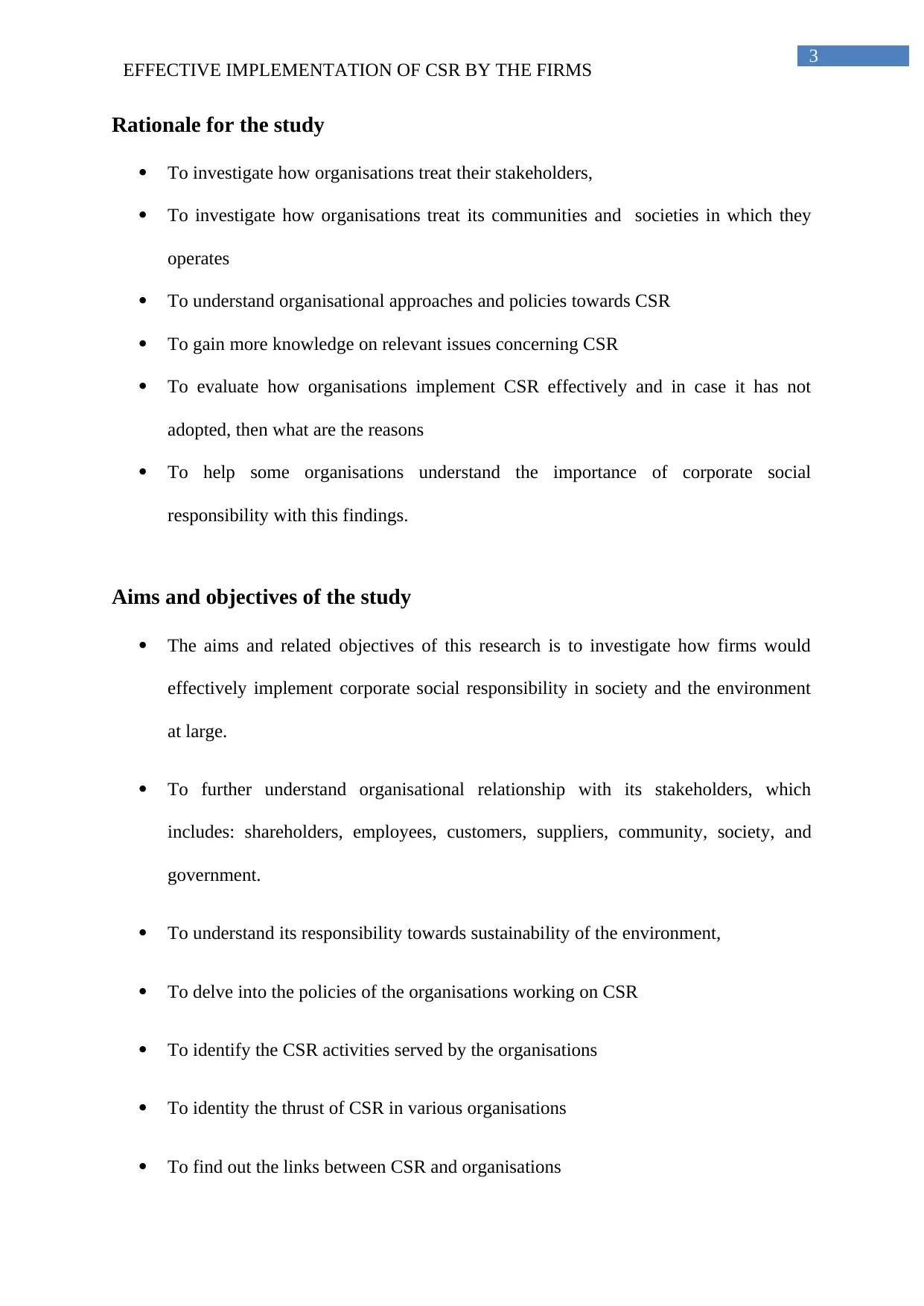
3
EFFECTIVE IMPLEMENTATION OF CSR BY THE FIRMS
Rationale for the study
To investigate how organisations treat their stakeholders,
To investigate how organisations treat its communities and societies in which they
operates
To understand organisational approaches and policies towards CSR
To gain more knowledge on relevant issues concerning CSR
To evaluate how organisations implement CSR effectively and in case it has not
adopted, then what are the reasons
To help some organisations understand the importance of corporate social
responsibility with this findings.
Aims and objectives of the study
The aims and related objectives of this research is to investigate how firms would
effectively implement corporate social responsibility in society and the environment
at large.
To further understand organisational relationship with its stakeholders, which
includes: shareholders, employees, customers, suppliers, community, society, and
government.
To understand its responsibility towards sustainability of the environment,
To delve into the policies of the organisations working on CSR
To identify the CSR activities served by the organisations
To identity the thrust of CSR in various organisations
To find out the links between CSR and organisations
EFFECTIVE IMPLEMENTATION OF CSR BY THE FIRMS
Rationale for the study
To investigate how organisations treat their stakeholders,
To investigate how organisations treat its communities and societies in which they
operates
To understand organisational approaches and policies towards CSR
To gain more knowledge on relevant issues concerning CSR
To evaluate how organisations implement CSR effectively and in case it has not
adopted, then what are the reasons
To help some organisations understand the importance of corporate social
responsibility with this findings.
Aims and objectives of the study
The aims and related objectives of this research is to investigate how firms would
effectively implement corporate social responsibility in society and the environment
at large.
To further understand organisational relationship with its stakeholders, which
includes: shareholders, employees, customers, suppliers, community, society, and
government.
To understand its responsibility towards sustainability of the environment,
To delve into the policies of the organisations working on CSR
To identify the CSR activities served by the organisations
To identity the thrust of CSR in various organisations
To find out the links between CSR and organisations
Paraphrase This Document
Need a fresh take? Get an instant paraphrase of this document with our AI Paraphraser
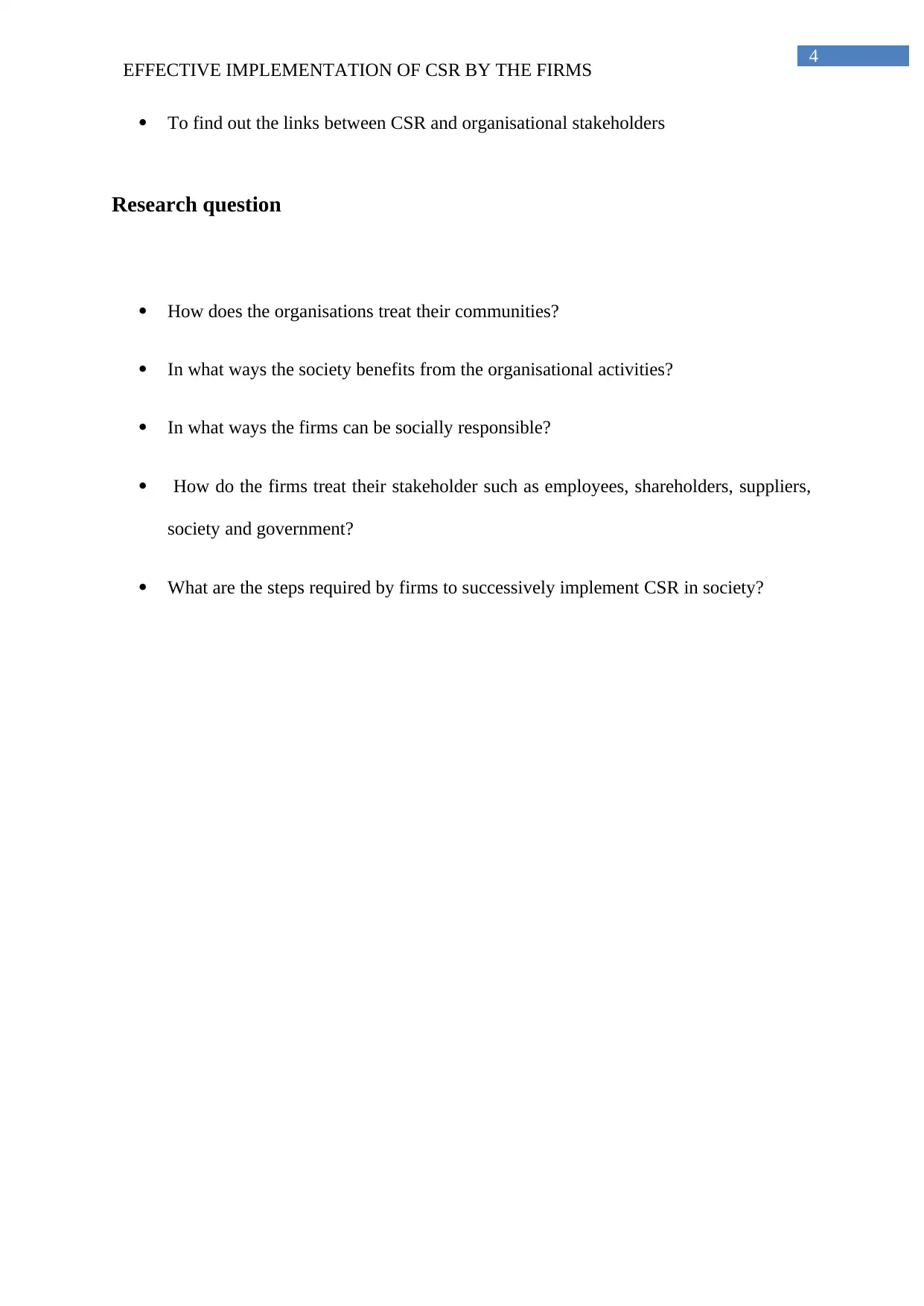
4
EFFECTIVE IMPLEMENTATION OF CSR BY THE FIRMS
To find out the links between CSR and organisational stakeholders
Research question
How does the organisations treat their communities?
In what ways the society benefits from the organisational activities?
In what ways the firms can be socially responsible?
How do the firms treat their stakeholder such as employees, shareholders, suppliers,
society and government?
What are the steps required by firms to successively implement CSR in society?
EFFECTIVE IMPLEMENTATION OF CSR BY THE FIRMS
To find out the links between CSR and organisational stakeholders
Research question
How does the organisations treat their communities?
In what ways the society benefits from the organisational activities?
In what ways the firms can be socially responsible?
How do the firms treat their stakeholder such as employees, shareholders, suppliers,
society and government?
What are the steps required by firms to successively implement CSR in society?
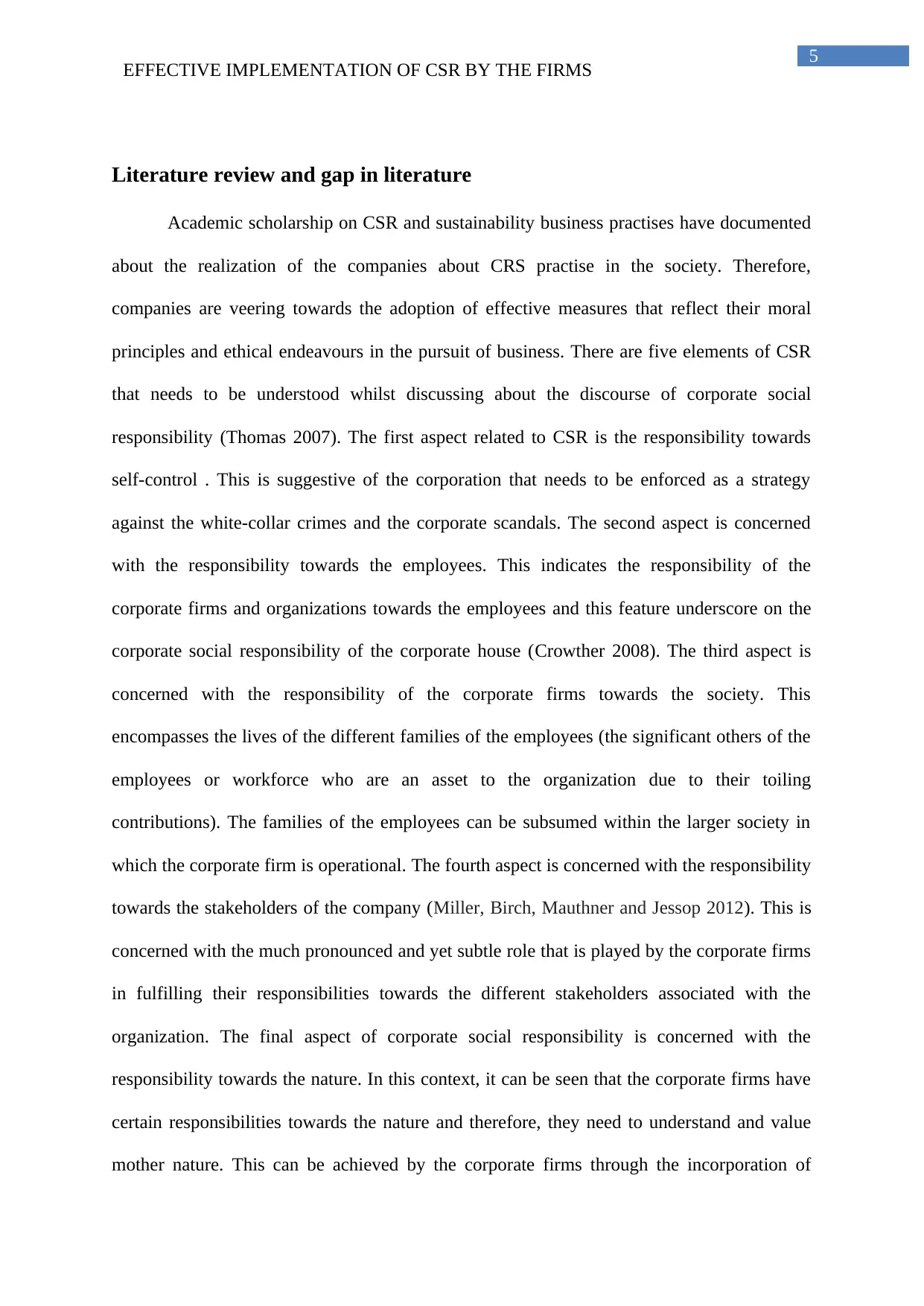
5
EFFECTIVE IMPLEMENTATION OF CSR BY THE FIRMS
Literature review and gap in literature
Academic scholarship on CSR and sustainability business practises have documented
about the realization of the companies about CRS practise in the society. Therefore,
companies are veering towards the adoption of effective measures that reflect their moral
principles and ethical endeavours in the pursuit of business. There are five elements of CSR
that needs to be understood whilst discussing about the discourse of corporate social
responsibility (Thomas 2007). The first aspect related to CSR is the responsibility towards
self-control . This is suggestive of the corporation that needs to be enforced as a strategy
against the white-collar crimes and the corporate scandals. The second aspect is concerned
with the responsibility towards the employees. This indicates the responsibility of the
corporate firms and organizations towards the employees and this feature underscore on the
corporate social responsibility of the corporate house (Crowther 2008). The third aspect is
concerned with the responsibility of the corporate firms towards the society. This
encompasses the lives of the different families of the employees (the significant others of the
employees or workforce who are an asset to the organization due to their toiling
contributions). The families of the employees can be subsumed within the larger society in
which the corporate firm is operational. The fourth aspect is concerned with the responsibility
towards the stakeholders of the company (Miller, Birch, Mauthner and Jessop 2012). This is
concerned with the much pronounced and yet subtle role that is played by the corporate firms
in fulfilling their responsibilities towards the different stakeholders associated with the
organization. The final aspect of corporate social responsibility is concerned with the
responsibility towards the nature. In this context, it can be seen that the corporate firms have
certain responsibilities towards the nature and therefore, they need to understand and value
mother nature. This can be achieved by the corporate firms through the incorporation of
EFFECTIVE IMPLEMENTATION OF CSR BY THE FIRMS
Literature review and gap in literature
Academic scholarship on CSR and sustainability business practises have documented
about the realization of the companies about CRS practise in the society. Therefore,
companies are veering towards the adoption of effective measures that reflect their moral
principles and ethical endeavours in the pursuit of business. There are five elements of CSR
that needs to be understood whilst discussing about the discourse of corporate social
responsibility (Thomas 2007). The first aspect related to CSR is the responsibility towards
self-control . This is suggestive of the corporation that needs to be enforced as a strategy
against the white-collar crimes and the corporate scandals. The second aspect is concerned
with the responsibility towards the employees. This indicates the responsibility of the
corporate firms and organizations towards the employees and this feature underscore on the
corporate social responsibility of the corporate house (Crowther 2008). The third aspect is
concerned with the responsibility of the corporate firms towards the society. This
encompasses the lives of the different families of the employees (the significant others of the
employees or workforce who are an asset to the organization due to their toiling
contributions). The families of the employees can be subsumed within the larger society in
which the corporate firm is operational. The fourth aspect is concerned with the responsibility
towards the stakeholders of the company (Miller, Birch, Mauthner and Jessop 2012). This is
concerned with the much pronounced and yet subtle role that is played by the corporate firms
in fulfilling their responsibilities towards the different stakeholders associated with the
organization. The final aspect of corporate social responsibility is concerned with the
responsibility towards the nature. In this context, it can be seen that the corporate firms have
certain responsibilities towards the nature and therefore, they need to understand and value
mother nature. This can be achieved by the corporate firms through the incorporation of
⊘ This is a preview!⊘
Do you want full access?
Subscribe today to unlock all pages.

Trusted by 1+ million students worldwide
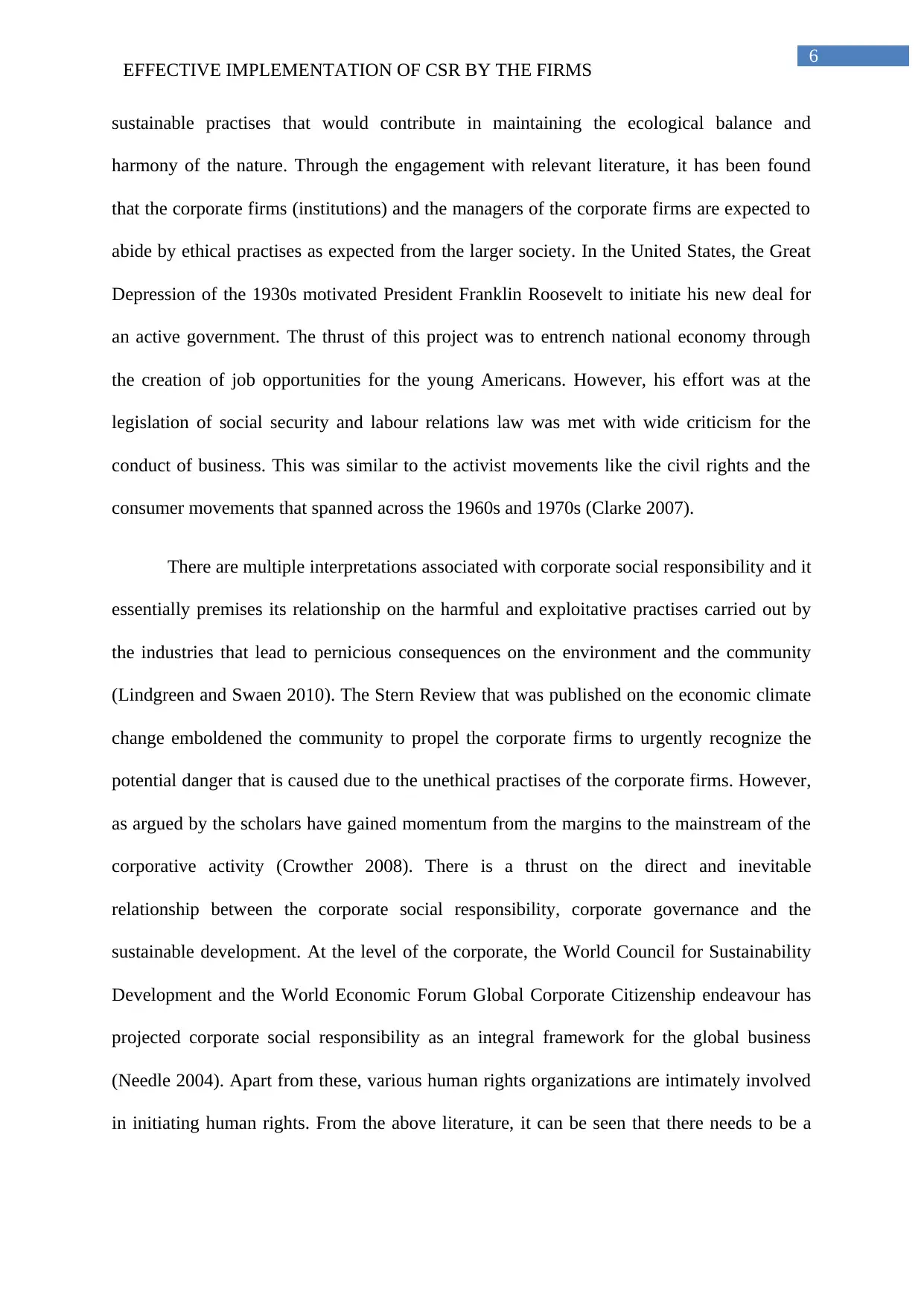
6
EFFECTIVE IMPLEMENTATION OF CSR BY THE FIRMS
sustainable practises that would contribute in maintaining the ecological balance and
harmony of the nature. Through the engagement with relevant literature, it has been found
that the corporate firms (institutions) and the managers of the corporate firms are expected to
abide by ethical practises as expected from the larger society. In the United States, the Great
Depression of the 1930s motivated President Franklin Roosevelt to initiate his new deal for
an active government. The thrust of this project was to entrench national economy through
the creation of job opportunities for the young Americans. However, his effort was at the
legislation of social security and labour relations law was met with wide criticism for the
conduct of business. This was similar to the activist movements like the civil rights and the
consumer movements that spanned across the 1960s and 1970s (Clarke 2007).
There are multiple interpretations associated with corporate social responsibility and it
essentially premises its relationship on the harmful and exploitative practises carried out by
the industries that lead to pernicious consequences on the environment and the community
(Lindgreen and Swaen 2010). The Stern Review that was published on the economic climate
change emboldened the community to propel the corporate firms to urgently recognize the
potential danger that is caused due to the unethical practises of the corporate firms. However,
as argued by the scholars have gained momentum from the margins to the mainstream of the
corporative activity (Crowther 2008). There is a thrust on the direct and inevitable
relationship between the corporate social responsibility, corporate governance and the
sustainable development. At the level of the corporate, the World Council for Sustainability
Development and the World Economic Forum Global Corporate Citizenship endeavour has
projected corporate social responsibility as an integral framework for the global business
(Needle 2004). Apart from these, various human rights organizations are intimately involved
in initiating human rights. From the above literature, it can be seen that there needs to be a
EFFECTIVE IMPLEMENTATION OF CSR BY THE FIRMS
sustainable practises that would contribute in maintaining the ecological balance and
harmony of the nature. Through the engagement with relevant literature, it has been found
that the corporate firms (institutions) and the managers of the corporate firms are expected to
abide by ethical practises as expected from the larger society. In the United States, the Great
Depression of the 1930s motivated President Franklin Roosevelt to initiate his new deal for
an active government. The thrust of this project was to entrench national economy through
the creation of job opportunities for the young Americans. However, his effort was at the
legislation of social security and labour relations law was met with wide criticism for the
conduct of business. This was similar to the activist movements like the civil rights and the
consumer movements that spanned across the 1960s and 1970s (Clarke 2007).
There are multiple interpretations associated with corporate social responsibility and it
essentially premises its relationship on the harmful and exploitative practises carried out by
the industries that lead to pernicious consequences on the environment and the community
(Lindgreen and Swaen 2010). The Stern Review that was published on the economic climate
change emboldened the community to propel the corporate firms to urgently recognize the
potential danger that is caused due to the unethical practises of the corporate firms. However,
as argued by the scholars have gained momentum from the margins to the mainstream of the
corporative activity (Crowther 2008). There is a thrust on the direct and inevitable
relationship between the corporate social responsibility, corporate governance and the
sustainable development. At the level of the corporate, the World Council for Sustainability
Development and the World Economic Forum Global Corporate Citizenship endeavour has
projected corporate social responsibility as an integral framework for the global business
(Needle 2004). Apart from these, various human rights organizations are intimately involved
in initiating human rights. From the above literature, it can be seen that there needs to be a
Paraphrase This Document
Need a fresh take? Get an instant paraphrase of this document with our AI Paraphraser
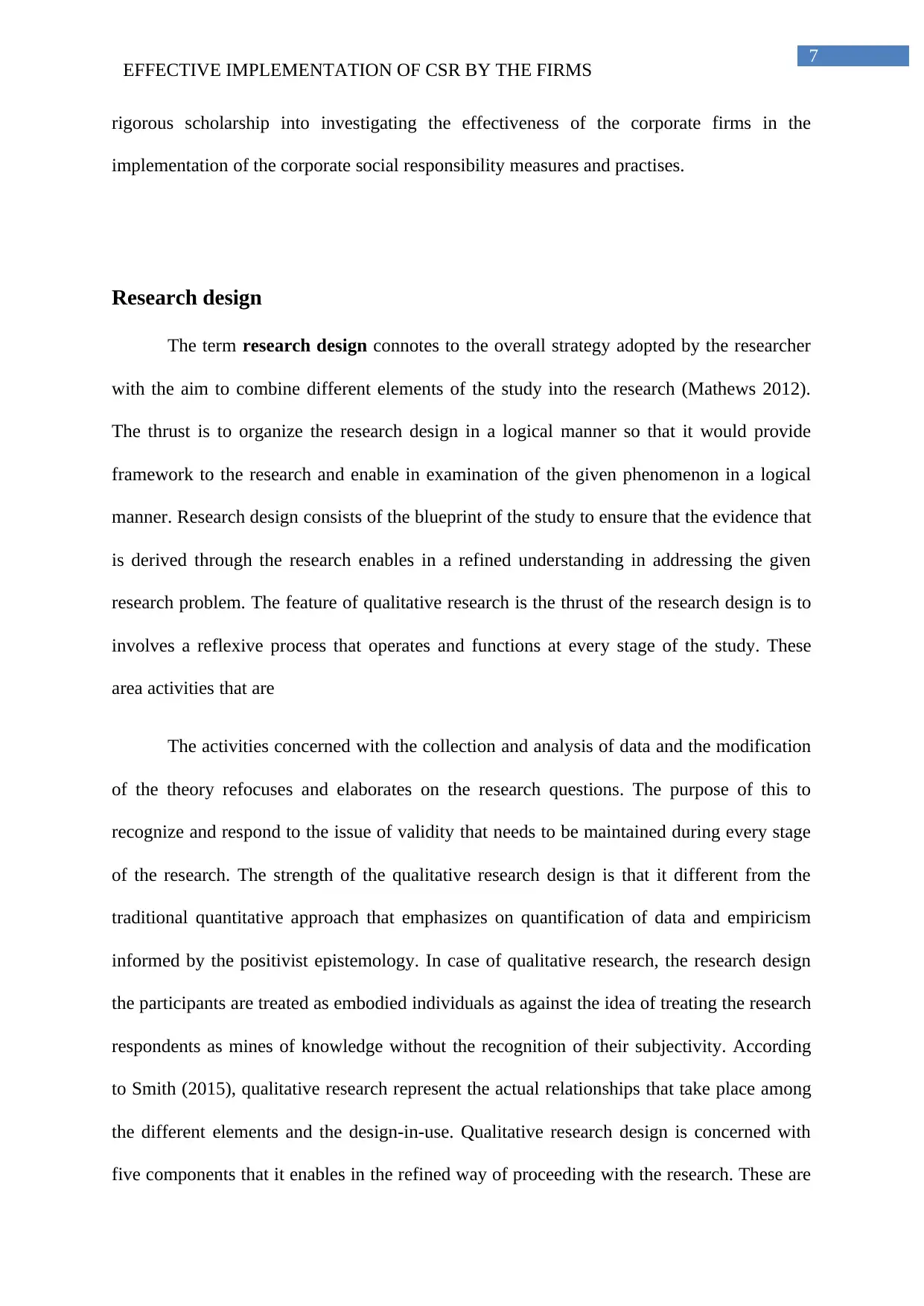
7
EFFECTIVE IMPLEMENTATION OF CSR BY THE FIRMS
rigorous scholarship into investigating the effectiveness of the corporate firms in the
implementation of the corporate social responsibility measures and practises.
Research design
The term research design connotes to the overall strategy adopted by the researcher
with the aim to combine different elements of the study into the research (Mathews 2012).
The thrust is to organize the research design in a logical manner so that it would provide
framework to the research and enable in examination of the given phenomenon in a logical
manner. Research design consists of the blueprint of the study to ensure that the evidence that
is derived through the research enables in a refined understanding in addressing the given
research problem. The feature of qualitative research is the thrust of the research design is to
involves a reflexive process that operates and functions at every stage of the study. These
area activities that are
The activities concerned with the collection and analysis of data and the modification
of the theory refocuses and elaborates on the research questions. The purpose of this to
recognize and respond to the issue of validity that needs to be maintained during every stage
of the research. The strength of the qualitative research design is that it different from the
traditional quantitative approach that emphasizes on quantification of data and empiricism
informed by the positivist epistemology. In case of qualitative research, the research design
the participants are treated as embodied individuals as against the idea of treating the research
respondents as mines of knowledge without the recognition of their subjectivity. According
to Smith (2015), qualitative research represent the actual relationships that take place among
the different elements and the design-in-use. Qualitative research design is concerned with
five components that it enables in the refined way of proceeding with the research. These are
EFFECTIVE IMPLEMENTATION OF CSR BY THE FIRMS
rigorous scholarship into investigating the effectiveness of the corporate firms in the
implementation of the corporate social responsibility measures and practises.
Research design
The term research design connotes to the overall strategy adopted by the researcher
with the aim to combine different elements of the study into the research (Mathews 2012).
The thrust is to organize the research design in a logical manner so that it would provide
framework to the research and enable in examination of the given phenomenon in a logical
manner. Research design consists of the blueprint of the study to ensure that the evidence that
is derived through the research enables in a refined understanding in addressing the given
research problem. The feature of qualitative research is the thrust of the research design is to
involves a reflexive process that operates and functions at every stage of the study. These
area activities that are
The activities concerned with the collection and analysis of data and the modification
of the theory refocuses and elaborates on the research questions. The purpose of this to
recognize and respond to the issue of validity that needs to be maintained during every stage
of the research. The strength of the qualitative research design is that it different from the
traditional quantitative approach that emphasizes on quantification of data and empiricism
informed by the positivist epistemology. In case of qualitative research, the research design
the participants are treated as embodied individuals as against the idea of treating the research
respondents as mines of knowledge without the recognition of their subjectivity. According
to Smith (2015), qualitative research represent the actual relationships that take place among
the different elements and the design-in-use. Qualitative research design is concerned with
five components that it enables in the refined way of proceeding with the research. These are
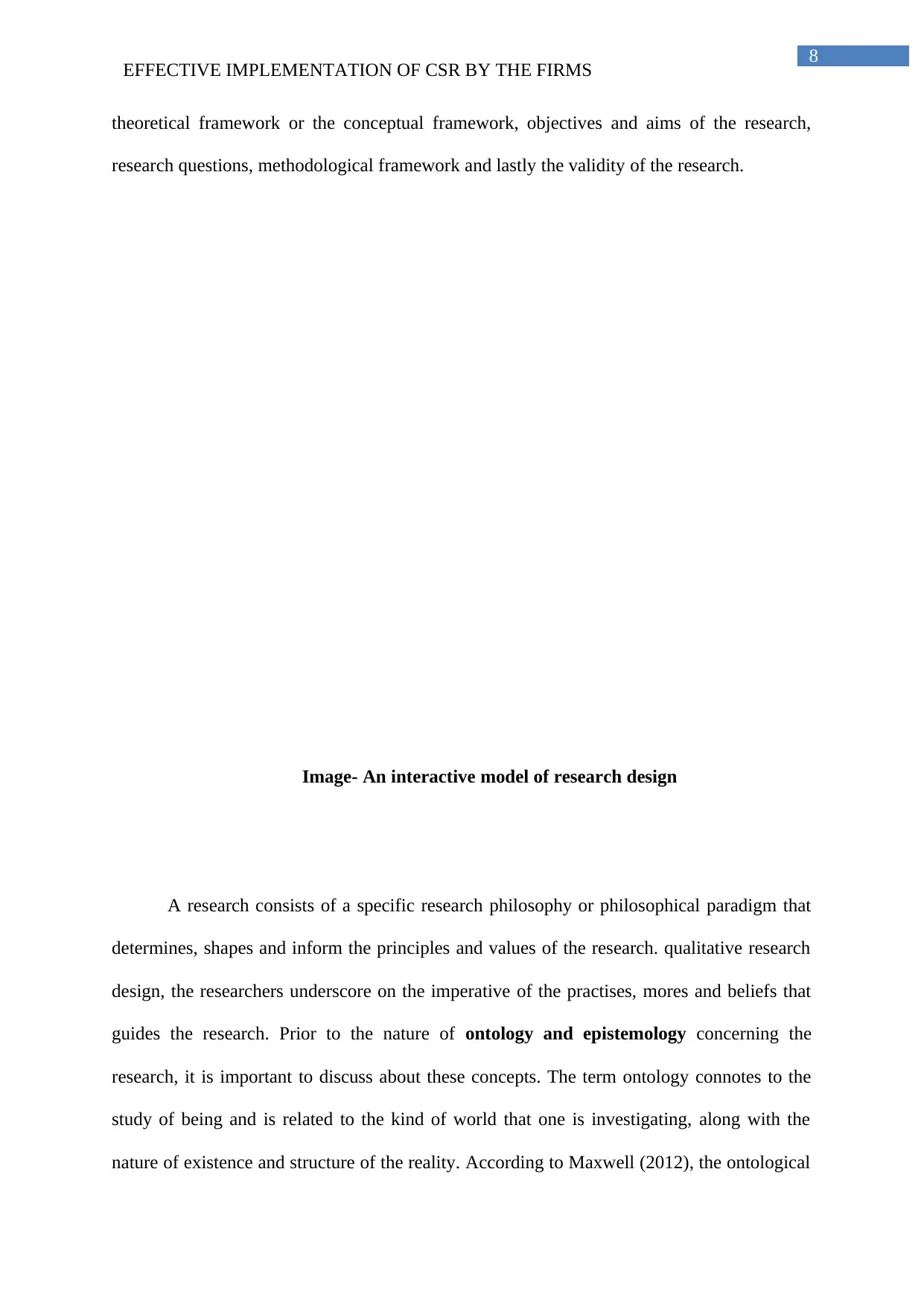
8
EFFECTIVE IMPLEMENTATION OF CSR BY THE FIRMS
theoretical framework or the conceptual framework, objectives and aims of the research,
research questions, methodological framework and lastly the validity of the research.
Image- An interactive model of research design
A research consists of a specific research philosophy or philosophical paradigm that
determines, shapes and inform the principles and values of the research. qualitative research
design, the researchers underscore on the imperative of the practises, mores and beliefs that
guides the research. Prior to the nature of ontology and epistemology concerning the
research, it is important to discuss about these concepts. The term ontology connotes to the
study of being and is related to the kind of world that one is investigating, along with the
nature of existence and structure of the reality. According to Maxwell (2012), the ontological
EFFECTIVE IMPLEMENTATION OF CSR BY THE FIRMS
theoretical framework or the conceptual framework, objectives and aims of the research,
research questions, methodological framework and lastly the validity of the research.
Image- An interactive model of research design
A research consists of a specific research philosophy or philosophical paradigm that
determines, shapes and inform the principles and values of the research. qualitative research
design, the researchers underscore on the imperative of the practises, mores and beliefs that
guides the research. Prior to the nature of ontology and epistemology concerning the
research, it is important to discuss about these concepts. The term ontology connotes to the
study of being and is related to the kind of world that one is investigating, along with the
nature of existence and structure of the reality. According to Maxwell (2012), the ontological
⊘ This is a preview!⊘
Do you want full access?
Subscribe today to unlock all pages.

Trusted by 1+ million students worldwide
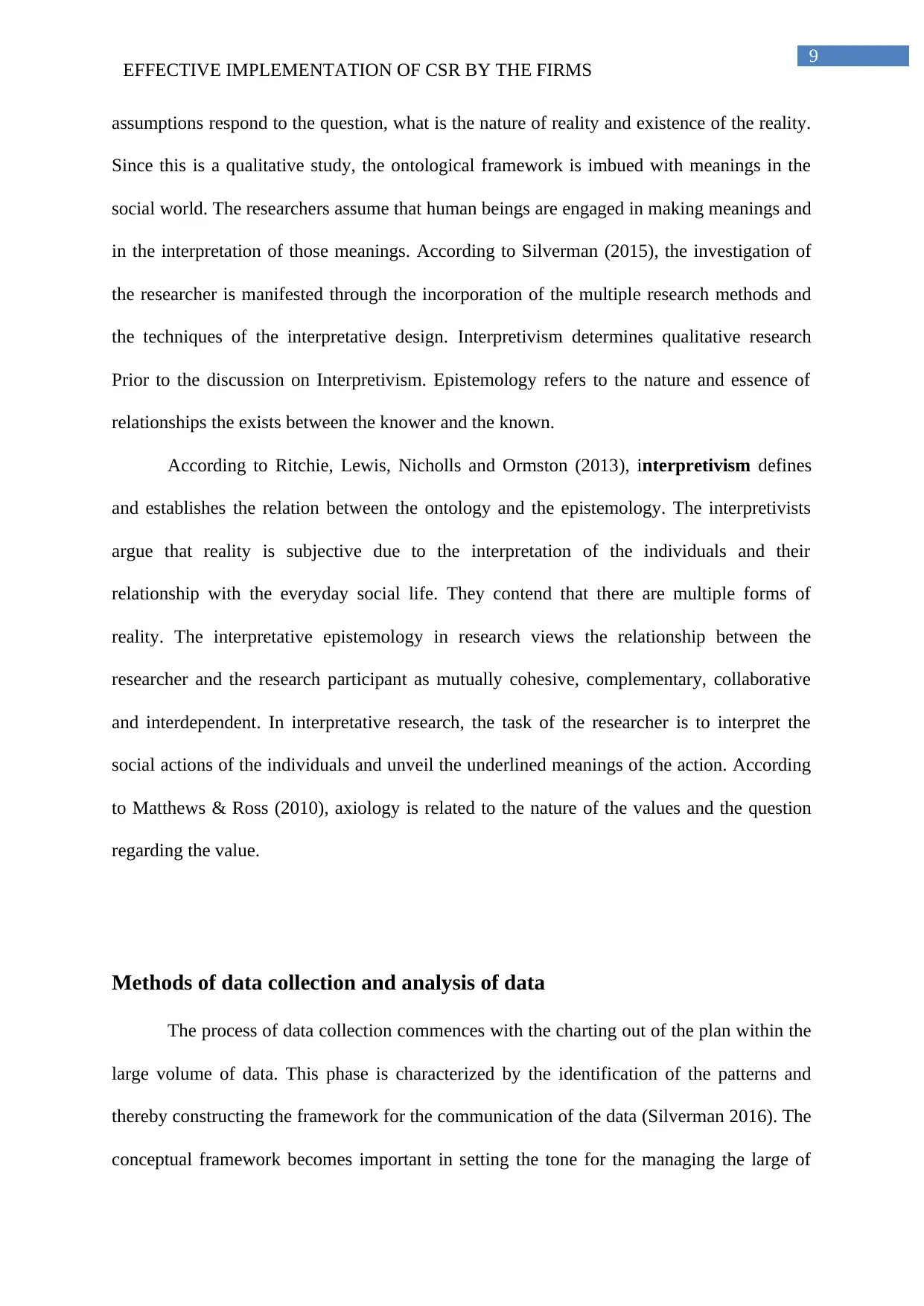
9
EFFECTIVE IMPLEMENTATION OF CSR BY THE FIRMS
assumptions respond to the question, what is the nature of reality and existence of the reality.
Since this is a qualitative study, the ontological framework is imbued with meanings in the
social world. The researchers assume that human beings are engaged in making meanings and
in the interpretation of those meanings. According to Silverman (2015), the investigation of
the researcher is manifested through the incorporation of the multiple research methods and
the techniques of the interpretative design. Interpretivism determines qualitative research
Prior to the discussion on Interpretivism. Epistemology refers to the nature and essence of
relationships the exists between the knower and the known.
According to Ritchie, Lewis, Nicholls and Ormston (2013), interpretivism defines
and establishes the relation between the ontology and the epistemology. The interpretivists
argue that reality is subjective due to the interpretation of the individuals and their
relationship with the everyday social life. They contend that there are multiple forms of
reality. The interpretative epistemology in research views the relationship between the
researcher and the research participant as mutually cohesive, complementary, collaborative
and interdependent. In interpretative research, the task of the researcher is to interpret the
social actions of the individuals and unveil the underlined meanings of the action. According
to Matthews & Ross (2010), axiology is related to the nature of the values and the question
regarding the value.
Methods of data collection and analysis of data
The process of data collection commences with the charting out of the plan within the
large volume of data. This phase is characterized by the identification of the patterns and
thereby constructing the framework for the communication of the data (Silverman 2016). The
conceptual framework becomes important in setting the tone for the managing the large of
EFFECTIVE IMPLEMENTATION OF CSR BY THE FIRMS
assumptions respond to the question, what is the nature of reality and existence of the reality.
Since this is a qualitative study, the ontological framework is imbued with meanings in the
social world. The researchers assume that human beings are engaged in making meanings and
in the interpretation of those meanings. According to Silverman (2015), the investigation of
the researcher is manifested through the incorporation of the multiple research methods and
the techniques of the interpretative design. Interpretivism determines qualitative research
Prior to the discussion on Interpretivism. Epistemology refers to the nature and essence of
relationships the exists between the knower and the known.
According to Ritchie, Lewis, Nicholls and Ormston (2013), interpretivism defines
and establishes the relation between the ontology and the epistemology. The interpretivists
argue that reality is subjective due to the interpretation of the individuals and their
relationship with the everyday social life. They contend that there are multiple forms of
reality. The interpretative epistemology in research views the relationship between the
researcher and the research participant as mutually cohesive, complementary, collaborative
and interdependent. In interpretative research, the task of the researcher is to interpret the
social actions of the individuals and unveil the underlined meanings of the action. According
to Matthews & Ross (2010), axiology is related to the nature of the values and the question
regarding the value.
Methods of data collection and analysis of data
The process of data collection commences with the charting out of the plan within the
large volume of data. This phase is characterized by the identification of the patterns and
thereby constructing the framework for the communication of the data (Silverman 2016). The
conceptual framework becomes important in setting the tone for the managing the large of
Paraphrase This Document
Need a fresh take? Get an instant paraphrase of this document with our AI Paraphraser
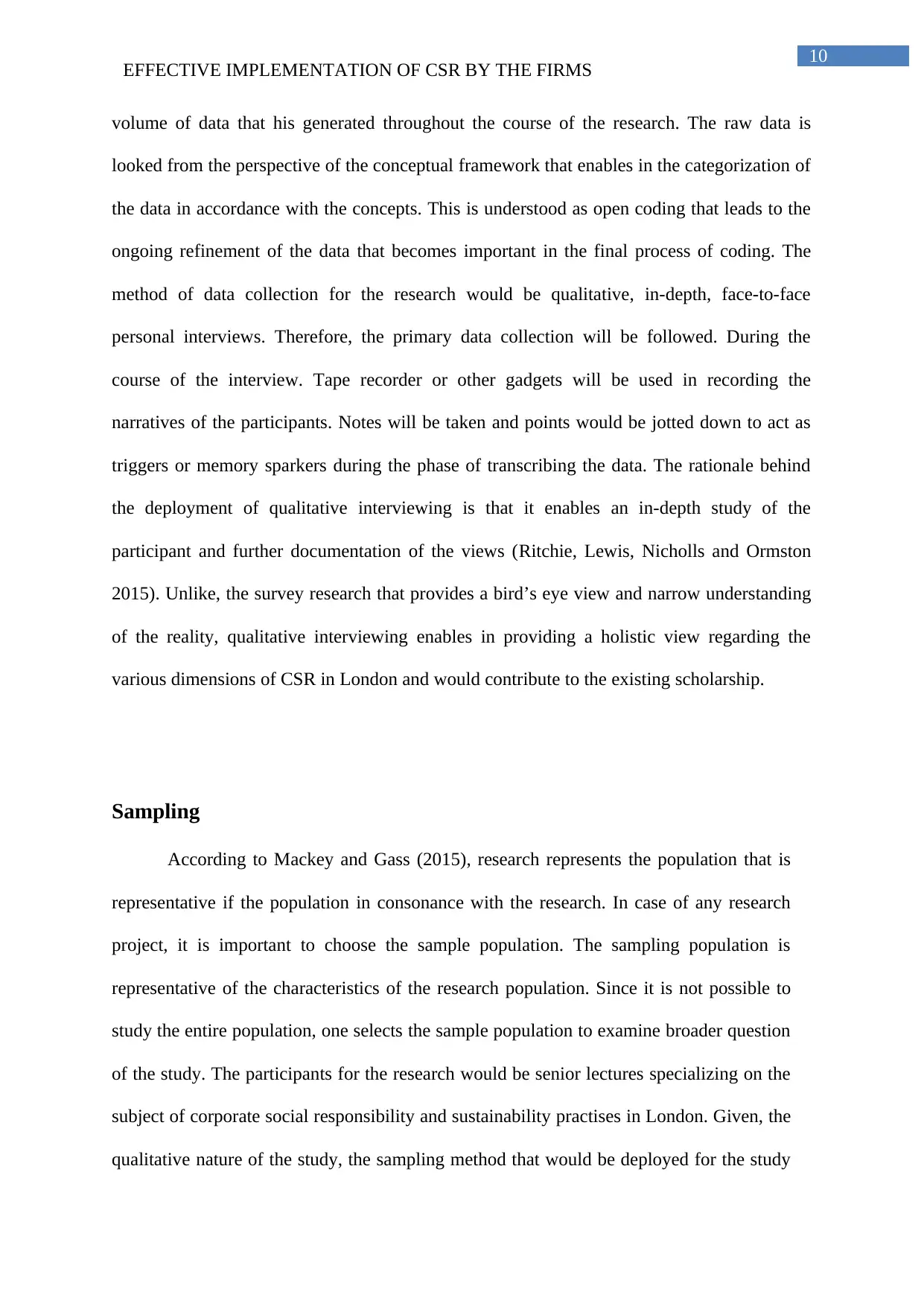
10
EFFECTIVE IMPLEMENTATION OF CSR BY THE FIRMS
volume of data that his generated throughout the course of the research. The raw data is
looked from the perspective of the conceptual framework that enables in the categorization of
the data in accordance with the concepts. This is understood as open coding that leads to the
ongoing refinement of the data that becomes important in the final process of coding. The
method of data collection for the research would be qualitative, in-depth, face-to-face
personal interviews. Therefore, the primary data collection will be followed. During the
course of the interview. Tape recorder or other gadgets will be used in recording the
narratives of the participants. Notes will be taken and points would be jotted down to act as
triggers or memory sparkers during the phase of transcribing the data. The rationale behind
the deployment of qualitative interviewing is that it enables an in-depth study of the
participant and further documentation of the views (Ritchie, Lewis, Nicholls and Ormston
2015). Unlike, the survey research that provides a bird’s eye view and narrow understanding
of the reality, qualitative interviewing enables in providing a holistic view regarding the
various dimensions of CSR in London and would contribute to the existing scholarship.
Sampling
According to Mackey and Gass (2015), research represents the population that is
representative if the population in consonance with the research. In case of any research
project, it is important to choose the sample population. The sampling population is
representative of the characteristics of the research population. Since it is not possible to
study the entire population, one selects the sample population to examine broader question
of the study. The participants for the research would be senior lectures specializing on the
subject of corporate social responsibility and sustainability practises in London. Given, the
qualitative nature of the study, the sampling method that would be deployed for the study
EFFECTIVE IMPLEMENTATION OF CSR BY THE FIRMS
volume of data that his generated throughout the course of the research. The raw data is
looked from the perspective of the conceptual framework that enables in the categorization of
the data in accordance with the concepts. This is understood as open coding that leads to the
ongoing refinement of the data that becomes important in the final process of coding. The
method of data collection for the research would be qualitative, in-depth, face-to-face
personal interviews. Therefore, the primary data collection will be followed. During the
course of the interview. Tape recorder or other gadgets will be used in recording the
narratives of the participants. Notes will be taken and points would be jotted down to act as
triggers or memory sparkers during the phase of transcribing the data. The rationale behind
the deployment of qualitative interviewing is that it enables an in-depth study of the
participant and further documentation of the views (Ritchie, Lewis, Nicholls and Ormston
2015). Unlike, the survey research that provides a bird’s eye view and narrow understanding
of the reality, qualitative interviewing enables in providing a holistic view regarding the
various dimensions of CSR in London and would contribute to the existing scholarship.
Sampling
According to Mackey and Gass (2015), research represents the population that is
representative if the population in consonance with the research. In case of any research
project, it is important to choose the sample population. The sampling population is
representative of the characteristics of the research population. Since it is not possible to
study the entire population, one selects the sample population to examine broader question
of the study. The participants for the research would be senior lectures specializing on the
subject of corporate social responsibility and sustainability practises in London. Given, the
qualitative nature of the study, the sampling method that would be deployed for the study
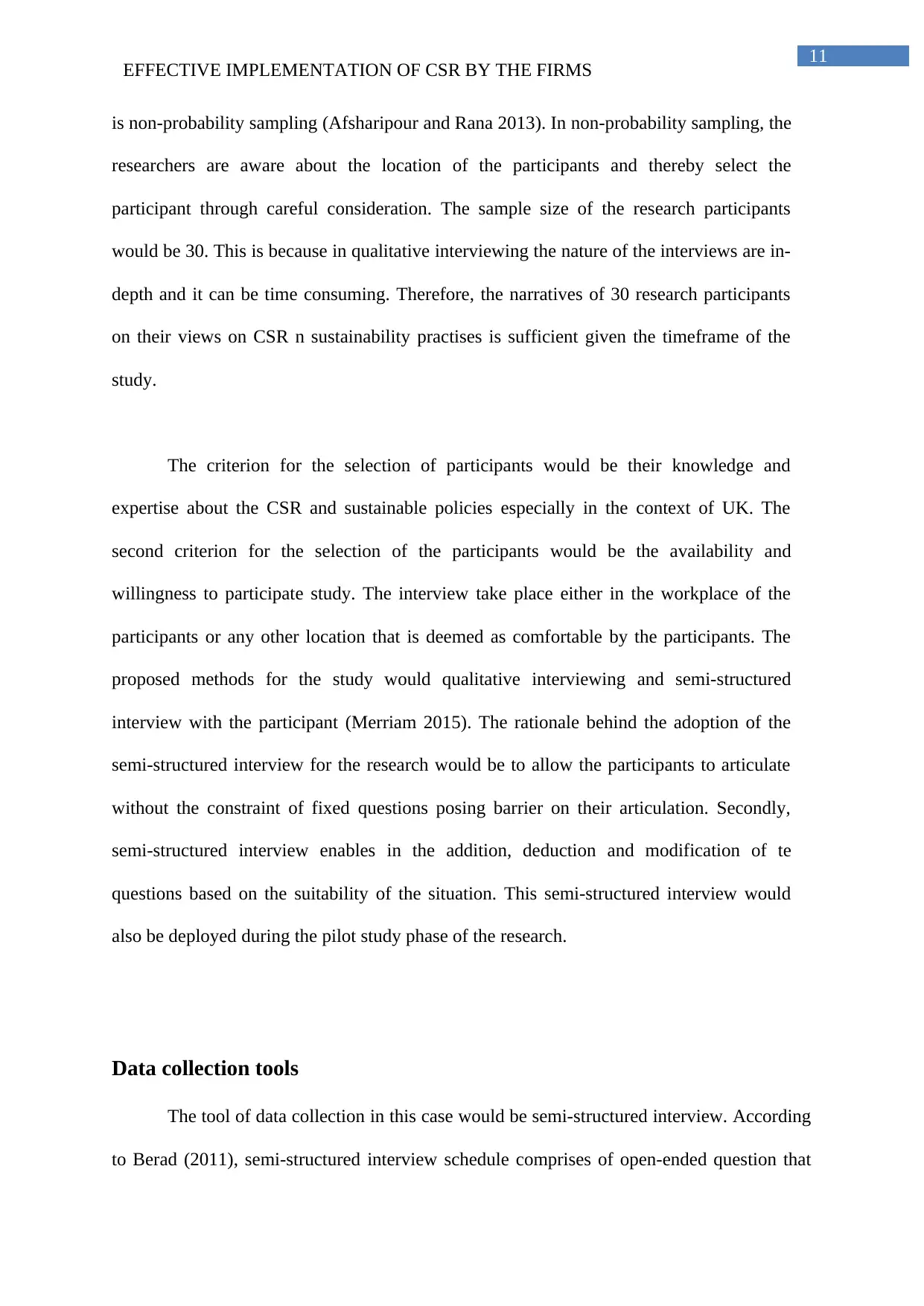
11
EFFECTIVE IMPLEMENTATION OF CSR BY THE FIRMS
is non-probability sampling (Afsharipour and Rana 2013). In non-probability sampling, the
researchers are aware about the location of the participants and thereby select the
participant through careful consideration. The sample size of the research participants
would be 30. This is because in qualitative interviewing the nature of the interviews are in-
depth and it can be time consuming. Therefore, the narratives of 30 research participants
on their views on CSR n sustainability practises is sufficient given the timeframe of the
study.
The criterion for the selection of participants would be their knowledge and
expertise about the CSR and sustainable policies especially in the context of UK. The
second criterion for the selection of the participants would be the availability and
willingness to participate study. The interview take place either in the workplace of the
participants or any other location that is deemed as comfortable by the participants. The
proposed methods for the study would qualitative interviewing and semi-structured
interview with the participant (Merriam 2015). The rationale behind the adoption of the
semi-structured interview for the research would be to allow the participants to articulate
without the constraint of fixed questions posing barrier on their articulation. Secondly,
semi-structured interview enables in the addition, deduction and modification of te
questions based on the suitability of the situation. This semi-structured interview would
also be deployed during the pilot study phase of the research.
Data collection tools
The tool of data collection in this case would be semi-structured interview. According
to Berad (2011), semi-structured interview schedule comprises of open-ended question that
EFFECTIVE IMPLEMENTATION OF CSR BY THE FIRMS
is non-probability sampling (Afsharipour and Rana 2013). In non-probability sampling, the
researchers are aware about the location of the participants and thereby select the
participant through careful consideration. The sample size of the research participants
would be 30. This is because in qualitative interviewing the nature of the interviews are in-
depth and it can be time consuming. Therefore, the narratives of 30 research participants
on their views on CSR n sustainability practises is sufficient given the timeframe of the
study.
The criterion for the selection of participants would be their knowledge and
expertise about the CSR and sustainable policies especially in the context of UK. The
second criterion for the selection of the participants would be the availability and
willingness to participate study. The interview take place either in the workplace of the
participants or any other location that is deemed as comfortable by the participants. The
proposed methods for the study would qualitative interviewing and semi-structured
interview with the participant (Merriam 2015). The rationale behind the adoption of the
semi-structured interview for the research would be to allow the participants to articulate
without the constraint of fixed questions posing barrier on their articulation. Secondly,
semi-structured interview enables in the addition, deduction and modification of te
questions based on the suitability of the situation. This semi-structured interview would
also be deployed during the pilot study phase of the research.
Data collection tools
The tool of data collection in this case would be semi-structured interview. According
to Berad (2011), semi-structured interview schedule comprises of open-ended question that
⊘ This is a preview!⊘
Do you want full access?
Subscribe today to unlock all pages.

Trusted by 1+ million students worldwide
1 out of 21
Related Documents
Your All-in-One AI-Powered Toolkit for Academic Success.
+13062052269
info@desklib.com
Available 24*7 on WhatsApp / Email
![[object Object]](/_next/static/media/star-bottom.7253800d.svg)
Unlock your academic potential
Copyright © 2020–2025 A2Z Services. All Rights Reserved. Developed and managed by ZUCOL.




